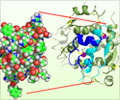A comprehensive diabetes program for low-income, poorly-diabetics significantly improved blood sugar control, say John Hopkins researchers who designed an implemented the program.

"We know that people need information to manage their disease, but having knowledge of the facts is not enough for behavioral change," says Felicia Hill-Briggs, Ph.D., an associate professor in the Division of General Internal Medicine at the Johns Hopkins University School of Medicine and the study's lead author. "With this novel approach, we have found a way to give people the skills to solve problems in all areas of their lives so that they can take diabetes off the back burner and start caring for their health."
In the small study, 56 participants were randomized into one of two groups. One got the intensive, nine-session, problem-solving course that covered not only standard diabetes self-management and care, but taught problem-solving as a skill to help manage the financial, social, resource, and interpersonal issues that often stand in the way of their managing their diabetes. The other group got a condensed two-session version of the program.
Three months after the end of the program, participants in the intensive group saw their hemoglobin A1C levels a long-term measure of blood sugar fall by an average of .7 as compared with their levels before the start of the program. Levels below 5.7 are considered normal, while the target for people with diabetes is below 7.0. One participant stopped needing insulin after the completion of the program, Hill-Briggs says. The participants in the condensed program saw no improvement in their A1C levels.
Many who took part in the intensive program saw high cholesterol and high blood pressure drop as well. What struck Hill-Briggs most about her research was that A1C levels improved three months after the program was over. This is in contrast to many diabetes interventions, particularly with lower socioeconomic groups. "When the program stops and support is taken away, the behavior stops and the benefits stop," she says.
Hill-Briggs says she thinks one of the reasons for the sustained improvement in her study is that if problem solving as a life skill has been taught successfully, people see those skills improve as they use them more.
Advertisement
Hill-Briggs says the intensive program like many other diabetes education programs first focused on how to better manage the disease and prevent further dangerous complications such as kidney disease, poor circulation requiring foot and other amputations, and blindness. Facilitators explained the importance of a healthy diet, exercise, adherence to medication and self-monitoring. They did so using materials designed for a fifth-grade reading level to better reach this group, in which one in three participants had very low literacy skills.
Advertisement
In response, the program taught participants problem solving as a way to manage these challenges. Participants applied their problem-solving skills in individual ways to address their own unique life situations. Some, for example, began to see their budgets in terms of must-haves and wants. Often, she says, participants saw rent and electricity as must-haves and not diabetes medication, because their chronic disease didn't bother them enough to be considered an urgent need. With an understanding of the role of their medicines, participants described moving them to the must-have list and taking off something else that was a want.
For those who thought medication did not work, possible solutions they came up with included taking it consistently as prescribed for a week, then testing blood sugar to see what had happened. When results were good, subjects were encouraged and the results reinforced the need for consistent self-care.
Participants were also taught about making the best choices when foods such as fresh fruits and vegetables were not available. Often, only canned products are available in neighborhoods with little access to large grocery stores. Two participants, on their own, convinced their small local grocers to stock the low sodium varieties of vegetables, enabling them to make healthier choices.
"We helped people integrate diabetes care into everything else that was going on in their lives and in the context of how those things affected their health," Hill-Briggs says. "The struggle is these other things seem more immediate, because if today they're having a crisis, that is the focus. The diabetes is always there. We helped them understand that their diabetes can be a priority, and problem solving lets us meet them where they are. We help them improve their diabetes self-care by using a reliable skill to tackle the problems that come up everyday that used to throw them off their game plan."
Source-Eurekalert















